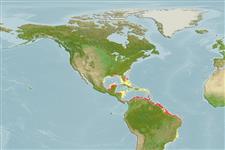Issue
The species Achirus lineatus Quoy & Gaimard, 1824 is cited as valid by Dennis et al. (2004: Ref. 51183) from Puerto Rico, followed by Eschmeyer (CofF ver. July 2013: Ref. 93826). However, a complete revision of the genus is necessary to sort out the difficulties. The distribution of A. achirus is referrred by Chabanaud (1928: 23) as "West coast of Americas, including West Indies. Cited from 7°N from 34°S.", and Cervigon (1966: 812) as "north and east of Gulf of Mexico to Rio Grande do Sul state, Brazil" (data on both papers are coincident). Cervigón (1996: 16) states: "its distribution extends from Golfo de Paria to Amazonas". No papers dealing with Achiridae include reference to a punctual collection of A. achirus in Gulf of Mexico or West Indies; Meek and Hildebrand (1928) do not cite this species to Panama. A. achirus was described from Suriname, and there are records from Venezuela, Suriname (the original description and other papers which refer to it), and Brazil (Figueirerdo & Menezes, 2000, Rosa, 1980). A. achirus securely do not occurs in southeastern South America (Figueirerdo & Menezes, 2000), the most south collection was taken at Paraíba state, northeastern Brazil (Rosa, 1980). The probable distribution of A. achirus is the coastal areas from Venezuela to northeastern Brazil, but it's necessary further studies to make a secure statement on distribution of this species. As several achirid species, it is a marine species which occasionally enters freshwaters; there is at least on record of this species for freshwater (Tocantins River at Cametá, Pará state, Brazil). Ortega and Vari (1986) cite A. achirus for freshwaters of Peru (Amazon basin), but it is a misidentification, as this species do not occurs in highland freshwaters. In this area occurs Hipoclinemus mentalis, which is frequently confounded with A. achirus.
Environment: milieu / climate zone / depth range / distribution range
Ökologie
seewasser; süßwasser; brackwasser demersal; amphidrom (Ref. 36739); tiefenbereich 1 - 20 m (Ref. 51483). Tropical; 25°C - 28°C (Ref. 12468)
Western Central Atlantic: from the Gulf of Paria to the mouth of the Amazon river.
Size / Gewicht / Alter
Maturity: Lm ? range ? - ? cm
Max length : 37.0 cm TL Männchen/unbestimmt; (Ref. 51483); common length : 30.0 cm TL Männchen/unbestimmt; (Ref. 5217); max. veröff. Gewicht: 1.0 kg (Ref. 5217)
Adults occur in the littoral zone, down to 20 m depth, and on all sandy-muddy bottoms of estuaries, rivers and coastal streams where it penetrates far enough sometimes. They hide completely in the sediment, leaving out its eyes, in order to look out for predators and prey. Feed on small crustaceans and fish. Reproduction is like to occur between July and September (Ref. 35237). Maximum length reported to reach 37 cm TL (Ref. 5217).
Life cycle and mating behavior
Geschlechtsreife | Fortpflanzung | Ablaichen | Eier | Fecundity | Larven
Cervigón, F., R. Cipriani, W. Fischer, L. Garibaldi, M. Hendrickx, A.J. Lemus, R. Márquez, J.M. Poutiers, G. Robaina and B. Rodriguez, 1992. Fichas FAO de identificación de especies para los fines de la pesca. Guía de campo de las especies comerciales marinas y de aquas salobres de la costa septentrional de Sur América. FAO, Rome. 513 p. Preparado con el financiamento de la Comisión de Comunidades Europeas y de NORAD. (Ref. 5217)
IUCN Rote Liste Status (Ref. 130435)
Bedrohung für Menschen
Harmless
Nutzung durch Menschen
Aquarium: Öffentliche Aquarien
Mehr Information
ReferenzenAquakulturAquakultur ProfilZuchtlinienGenetikElectrophoresesVererbbarkeitKrankheitenVerarbeitungNutrientsMass conversion
Tools
Zusatzinformationen
Download XML
Internet Quellen
Estimates based on models
Preferred temperature (Ref.
123201): 23.5 - 28.1, mean 27.3 °C (based on 940 cells).
Phylogenetic diversity index (Ref.
82804): PD
50 = 0.5020 [Uniqueness, from 0.5 = low to 2.0 = high].
Bayesian length-weight: a=0.00912 (0.00548 - 0.01519), b=3.04 (2.90 - 3.18), in cm total length, based on LWR estimates for this species & (Sub)family-body (Ref.
93245).
Trophic level (Ref.
69278): 4.0 ±0.66 se; based on food items.
Widerstandsfähigkeit (Ref.
120179): mittel, Verdopplung der Population dauert 1,4 - 4,4 Jahre. (Preliminary K or Fecundity.).
Fishing Vulnerability (Ref.
59153): Low to moderate vulnerability (27 of 100).
